
The First and Only Weekly Online Fanzine Devoted to the Life and Works of Edgar Rice Burroughs |
 |
Chattering From The Shoulder
#6
By Nkima
March 17, 2000
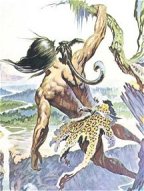
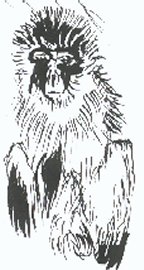

"Nkima scolded and chattered from the safety of his master's shoulder
..." (Invincible)
![]()
Tarzan
and the Jungle Murders:
Chapter
Summary & Commentary
![]()
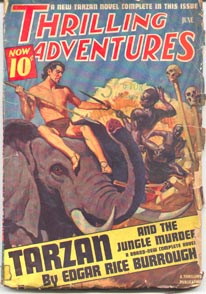
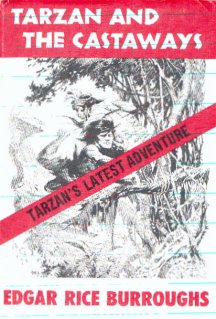
Chapter
Summary of
Tarzan
and the Jungle Murders
Introduction
This story was written by ERB in January of 1939. It was originally entitled "Murders in the Jungle." It appeared complete in one issue of Thrilling Adventures, June 1940. It can be found as the third story in the trilogy published as Tarzan and the Castaways.As Tarzan walks along a forest trail, a note in Dango, the hyena's, voice causes him to investigate. He finds a crashed Italian airplane surrounded by hyenas. Tarzan quickly disperses the beasts and finds the pilot dead in the cockpit, killed by a bullet through the throat. 
I. The Hyena's VoiceFootprints around the plane reveal that passengers have left the scene. Further investigations show that the pilot was shot from above, so Tarzan concludes that he was shot by someone in another plane.
Tarzan smells a glove and gets another clue. Footprints tell of two men who left two days ago.
Tarzan follows the two men and finds a second plane wreck, this one shot down by a machine gun. A used parachute tell him that the pilot in plane #2 has survived. He is an Englishman, Lieutenant Cecil Giles-Burton. Tarzan decides to follow him.
Horace Brown has invented a device designed to disrupt the ignition system of any internal combustion engine. Mary Graham tells the secret to Joseph Campbell, who along with Nikolai Zubanev, murders Brown and steals the plans. They sell the plans to the Great Man in Italy (obviously Benito Mussolini*) but are themselves robbed by Giles-Burton before the plans can be delivered. They follow him to Capetown by air. II. The Thread of Fate
(* Mussolini, "Il Duce" is also mentioned on page 203 of The Lad and the Lion.")
III. Broken Wings The villains shoot down the Englishman, but he walks into lion country with the secret plans.Burton gets through the country of the savage Buiroo cannibals, but Tarzan is wounded and captured. Tied up in the village, he pretends to pray and chant, but he is really calling the elephants to his rescue. Tantor is called by Tarzan's sixth sense and chanting cries. The elephants completely level the village and rescue Tarzan. 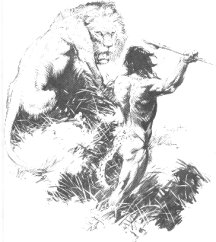
IV. Jungle CallBurton wanders in the jungle for weeks, starving, eating insects, until he finds the safari of Lord and Lady Ramsgate (brother and sister) former acquaintances. This safari has been linked with a Russian Romanoff safari by chance. Two derelicts, Smith and Peterson are also there. Burton fights Duncan Trent over Lady Barbara Ramsgate. He also argues and fights with two Russians. V. The Safari
Tarzan comes into the safari camp early in the morning to warm himself by the fire. He tells them he can smell a dead man in the camp. Ramsgate thinks he is a crazy wild man. Burton has been murdered. They decide that Tarzan is the guilty party. Trent tries to capture him with a pistol, but Tarzan escapes into the jungle. Around midnight Smith says that the crazy giant came back into camp and has stabbed Peterson to death. VI. The Coming of Tarzan
At Bangali Tarzan tells Col. Gerald Giles-Burton of his son's death and the suspicions about himself as the murderer. He learns about the secret papers. Ramsgate and Romanoff arrive in Bangali and the home of Col. Burton with his son's body. Tarzan investigates and finds that Smith and Peterson are really Campbell and Zubanev. He uses clues of finger bruises on the dead man's throat, a left-handed stab wound, and a limp in footprints for evidence of the real murderer. Tarzan takes the plans from Campbell, alias Smith, alias Joe the Pooch. He tells everyone that he really knew everything by scent without the other clues, then returns to the jungle. VII. Murder Will Out

CommentaryThe Mystery Story
What starts out to be a mystery to be solved by putting together clues in the time-honored fashion of the mystery story turns into a predictable tale with a strange interlude. The case is finally solved by Tarzan's uncanny sense of smell, so the clues are superfluous, and the mystery story is a flop. However, the strange interlude is worthy of note.
Burroughs obviously tried to write a Tarzan-Jungle Detective story, but by keeping Tarzan true to form with all of his superior senses he found that his Ape-Man could solve a case faster and easier than Sherlock Holmes. Tarzan had "solved" cases and had followed missing persons through trackless wastes in many of his previous novels. He tracked Jane's abductors through two of his greatest stories, Tarzan the Untamed and Tarzan the Terrible. He could find a needle in a haystack like a hunting hound, so this story was destined to fail before he wrote it.
According to Porges, in the original version sent to Thrilling Adventures, Tarzan appeared late in the story as "The Stranger." The story was "revised" by their editors to have Tarzan appear right away, and some of the wording and phrases by editorial hands are indeed suspect. In the first sentence of the story we are shocked by Tarzan's "breach-clout" instead of his usual "naked but for a g-string." We get a picture of Gandhi of the jungle or, at best, Mowgli rather than Tarzan of the Apes.
I wonder too at "Long experience had taught this man of the jungle the characteristic odors of both lion and zebra." It sounds like someone trying to explain who Tarzan is to people who know nothing about him. The fact that Tarzan can tell the difference in scent between a lion and a zebra is not even a startling fact. I could probably do the same.
Another sentence that grates is, "Tarzan preferred the evidence of his nostrils to any other way of finding things out." Ouch! It sounds like it was written by a grade school child who needs a few more lessons in English grammar. I can't believe that the "editors" improved this story very much.
The same paragraph concludes: "But the sense of smell never failed. It was always right; it always told a man what was what." Could ERB have been failing that much in 1939? It sounds to me like someone else writing about another man's character. Whoever wrote the opening paragraphs of Tarzan and the Jungle Murders, it was not a man comfortable with the Ape-Man.
The invective against Dango, the hyena, is especially strong. Tarzan even spits the taste out of his mouth as he is swinging through the trees. He spits at the hyenas again later on and "mutters" to himself. I suppose ERB could have written these things, but it would be interesting to see the original version before the editors made their changes. Changing the point of view of "The Stranger" to an overt "Tarzan of the Apes" could have caused problems in presentation that were not carried out with care.
Tarzan's Sixth Sense
The strange chapter IV "Jungle Call" presents an explanation of Tarzan's sixth sense that borders upon the uncanny. He actually senses that the elephants are near before he catches their scent. For some odd reason he pretends to pray, gradually increasing his volume as he calls Tantor's tribe to the rescue. Did he think that the cannibals would guess what he was doing and make him stop? It certainly is an strange episode. "Tarzan began to sway his torso backward and forward, gently, and a low chanting sound began to issue from his lips." It reminds me of "shuckling," the Jewish practice of swaying during prayers. (The idea here is to create a total immersion in one's prayers, physically, mentally, and spiritually, which may be related to Tarzan's sixth sense connection with the animals.) It also reminds me of a kind of sympathetic magic, imitation of the swaying and rocking of the elephants.
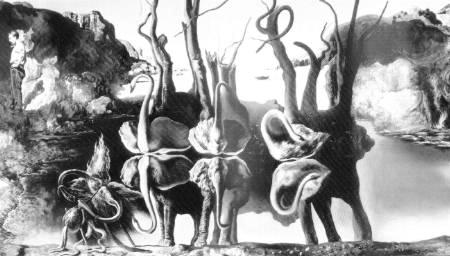
Tantor
Tarzan has always had a special relationship with Tantor the elephant. As early as chapter 2 "The Capture of Tarzan" in "The Jungle Tales of Tarzan" he had already developed an understanding with this "old friend." He saves Tantor from a native trap, and Tantor in turn saves him at the end of the story.
It seems that Tarzan and Tantor met years before this episode.
"Tarzan as a little child, had once fearlessly approached the great bull, assuming upon the part of the pachyderm the same friendliness which filled his own heart." (JT, 34).
Tarzan was able to call Tantor from great distances with a shrill and piercing call, which he used in "Jungle Murders." He also was able to direct the movement of the elephant by voice commands at this early age.
"Tantor would lumber through the jungle in any direction which his rider bade him go. It was the power of the man-mind over that of the brute and it was just as effective as though both fully understood its origin, though neither did." (JT, 34-35).
Tarzan the mahout may have had its spiritual origin in images from Kipling's India. However, Mowgli rode on Rama, a great bull buffalo, rather an elephant.
In Kipling's "Toomai of the Elephants" the relationship between Kala Nag, the great bull elephant, and Little Toomai seems to be more like Tarzan and Tantor. ". . . he had been born under Kala Nag's shadow, had played with the end of his trunk before he could walk, had taken him down to water as soon as he could walk, and Kala Nag would no more have dreamed of disobeying his shrill little orders than he would have dreamed of killing him . . ."(The Jungle Books) Toomai sees an elephant dance, a kind of wild elephant Dum-Dum, and is thus in favour of the elephant folk and the Gods of the Jungles. "If he slips before the feet of the charging bull-elephant, that bull-elephant shall know who he is and shall not crush him."
The British film "Elephant Boy" starring Sabu in his film debut was released in 1937, which is an interesting look at a Kiplingesque kind of hero. Of course, Tarzan had been riding elephants in the movies way back in the 1920s.
The End

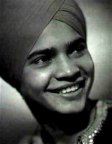
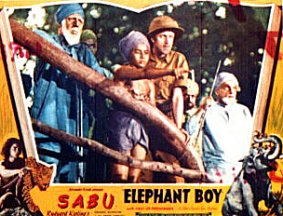


David Adams
Nkima and his friend, David Adams, would like to hear from ERB fans
davidadams@willmar.com
Nkima Chattering From The Shoulder
Read 'em all at:
ERBzine 0396
